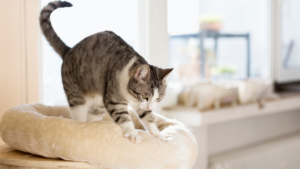
Cats are incredible creatures with unique personalities and behaviors that often leave us humans in awe. From the way they purr and knead their paws to their mysterious nocturnal adventures, cats have a language all their own. At Lost Our Home Pet Rescue, we’re passionate about helping cats find forever homes, and one of the keys to successful cat-human relationships is understanding feline behavior. In this post, we’ll delve into the world of cat behavior to help you decode your furry friend’s actions and deepen your bond.
The Power of Body Language:
Cats are masters of nonverbal communication, and much of their language is expressed through body movements and postures. Here are some common cat behaviors and what they typically mean:
Tail Language:
– Straight Up: A cat with its tail held high is generally feeling confident and friendly.
– Puffed Up: A puffed-up tail is a sign of fear or agitation, and your cat might feel threatened.
– Twitching: A twitching tail could signal excitement or irritation. Pay attention to other body cues to determine the context.
Ears:
– Forward and Upright: This indicates curiosity or interest.
– Pinned Back: Ears pinned back against the head often signal fear or aggression.
Eyes:
– Slow Blinking: When your cat slow-blinks at you, it’s a sign of trust and affection. Return the gesture to build a stronger bond.
Kneading:
– Cats knead with their paws to show contentment, often stemming from kittenhood when they kneaded their mother’s belly to stimulate milk flow.
Vocalization:
Cats also use vocalizations to communicate. While the meaning of meows can vary from cat to cat, here are some general ideas:
– Purring: Cats often purr when they’re relaxed, content, or seeking attention.
– Hissing and Growling: These are clear signs of anger, fear, or discomfort.
– Chirping and Chattering: Some cats make unique sounds while watching birds or prey, possibly out of frustration that they can’t reach them.
Cat Playtime:
Cats are natural hunters, and play is an essential part of their daily routine. Providing toys that mimic prey and engaging in interactive play sessions not only keeps your cat physically active but also strengthens your bond. It’s fascinating to observe your cat’s stalking and pouncing behaviors during play.
Territorial Instincts:
Cats are territorial creatures, and they often mark their territory through scent marking. Scratching is one way they do this, so providing a scratching post can help protect your furniture. Also, don’t be alarmed if your cat head-butts you or rubs against you—it’s a way of marking you as part of their territory.
Understanding Stress and Anxiety:
Cats can experience stress and anxiety, and it’s crucial to recognize the signs. These may include hiding, excessive grooming, or changes in appetite. If you notice these behaviors, consider the source of stress and try to alleviate it.
Deciphering cat behavior is a fascinating journey that deepens the bond between you and your feline friend. By paying attention to their body language, vocalizations, and playtime needs, you can better understand their unique personalities and provide a happy and enriching life. At Lost Our Home Pet Rescue, we believe that this understanding is key to creating loving and lasting relationships between cats and their human companions. If you’re considering adopting a cat, remember that each cat is unique, and taking the time to understand their behavior will help you provide the best possible home for them. Happy cat parenting!


